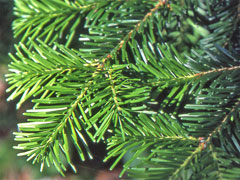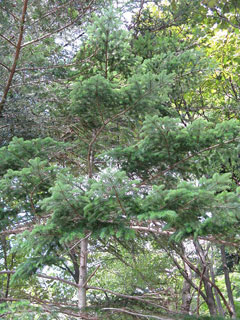 |
|
http://commons.wikimedia.org/wiki/File:Abies_veitchii4.JPG |
 |
|
Translate this page:
Summary
Physical Characteristics

 Abies veitchii is an evergreen Tree growing to 25 m (82ft 0in) at a fast rate.
Abies veitchii is an evergreen Tree growing to 25 m (82ft 0in) at a fast rate.
See above for USDA hardiness. It is hardy to UK zone 3 and is not frost tender. It is in leaf all year, in flower in June, and the seeds ripen from September to October. The species is monoecious (individual flowers are either male or female, but both sexes can be found on the same plant) and is pollinated by Wind.
Suitable for: light (sandy), medium (loamy) and heavy (clay) soils and can grow in heavy clay soil. Suitable pH: mildly acid and neutral soils. It can grow in full shade (deep woodland) semi-shade (light woodland) or no shade. It prefers moist soil.
UK Hardiness Map
US Hardiness Map
Synonyms
Plant Habitats
Woodland Garden Canopy;
Edible Uses
References More on Edible Uses
Medicinal Uses
Plants For A Future can not take any responsibility for any adverse effects from the use of plants. Always seek advice from a professional before using a plant medicinally.
None known
References More on Medicinal Uses
The Bookshop: Edible Plant Books
Our Latest books on Perennial Plants For Food Forests and Permaculture Gardens in paperback or digital formats.

Edible Tropical Plants
Food Forest Plants for Hotter Conditions: 250+ Plants For Tropical Food Forests & Permaculture Gardens.
More

Edible Temperate Plants
Plants for Your Food Forest: 500 Plants for Temperate Food Forests & Permaculture Gardens.
More

More Books
PFAF have eight books available in paperback and digital formats. Browse the shop for more information.
Shop Now
Other Uses
Wood
Wood - strong, elastic. Used for construction, boxes, utensils, spindles etc[61].
Special Uses
References More on Other Uses
Cultivation details
Prefers a good moist but not water-logged soil[1]. Grows well in heavy clay soils. Plants are very shade tolerant, especially when young, but growth is slower in dense shade[81]. Intolerant of atmospheric pollution[1]. Prefers slightly acid conditions down to a pH of about 5[200]. Prefers growing on a north-facing slope[200]. Not a long-lived tree, but it is relatively fast growing[11, 81]. Trees can put on new growth of 75cm two years after planting out and grow at up to 1 metre a year for the first 20 years or so of their life[185]. Growth rapidly tails off at this age, however, and trees often die quite soon afterwards[185]. Trees are very hardy, but in the milder winters of Britain they are often excited into premature growth and are then susceptible to damage by late frosts[1]. Trees grow best in the Perthshire valleys of Scotland[11]. Trees should be planted into their permanent positions when they are quite small, between 30 and 90cm in height. Larger trees will check badly and hardly put on any growth for several years. This also badly affects root development and wind resistance[200]. Plants are strongly outbreeding, self-fertilized seed usually grows poorly[200]. They hybridize freely with other members of this genus[200]. The flowers are produced in axils of the previous year's shoots[275]. Female flowers are produced relatively early in the life of the tree, usually by the time it is 6 metres tall[185]. This species is sometimes grown as a 'Christmas tree'[200].
References Carbon Farming Information and Carbon Sequestration Information
Temperature Converter
Type a value in the Celsius field to convert the value to Fahrenheit:
Fahrenheit:
The PFAF Bookshop
Plants For A Future have a number of books available in paperback and digital form. Book titles include Edible Plants, Edible Perennials, Edible Trees,Edible Shrubs, Woodland Gardening, and Temperate Food Forest Plants. Our new book is Food Forest Plants For Hotter Conditions (Tropical and Sub-Tropical).
Shop Now
Plant Propagation
Seed - sow early February in a greenhouse or outdoors in March[78]. Germination is often poor, usually taking about 6 - 8 weeks[78]. Stratification is said to produce a more even germination so it is probably best to sow the seed in a cold frame as soon as it is ripe in the autumn[80, 113]. The seed remains viable for up to 5 years if it is well stored[113]. When large enough to handle, prick the seedlings out into individual pots and grow them on for at least their first winter in pots. Plant them out into their permanent positions in late spring or early summer, after the last expected frosts. Alternatively, if you have sufficient seed, it is possible to sow in an outdoor seedbed. One report says that it is best to grow the seedlings on in the shade at a density of about 550 plants per square metre[78] whilst another report says that they are best grown on in a sunny position[80].
Other Names
If available other names are mentioned here
Native Range
TEMPERATE ASIA: Japan (Honshu, Shikoku)
Weed Potential
Right plant wrong place. We are currently updating this section.
Please note that a plant may be invasive in one area but may not in your area so it's worth checking.
Conservation Status
IUCN Red List of Threatened Plants Status :

| Related Plants
|
| Latin Name | Common Name | Habit | Height | Hardiness | Growth | Soil | Shade | Moisture | Edible | Medicinal | Other |
| Abies alba | Silver Fir, Christmas Tree Fir, European Silver Fir, Silver | Tree | 45.0 |
5-8
| F | LMH | FSN | M | 2 | 3 | 4 |
| Abies amabilis | Red Fir,Pacific silver fir | Tree | 30.0 |
4-8
| S | LMH | FSN | M | 1 | 2 | 3 |
| Abies balsamea | Balsam Fir | Tree | 15.0 |
3-6
| S | LMH | FSN | M | 3 | 5 | 3 |
| Abies cephalonica | Grecian Fir | Tree | 36.0 |
4-8
| M | LMH | FSN | M | 0 | 0 | 2 |
| Abies concolor | Colorado Fir, White fir | Tree | 45.0 |
3-7
| F | LMH | FSN | DM | 1 | 2 | 2 |
| Abies delavayi | | Tree | 25.0 |
6-9
| S | LMH | FSN | M | 0 | 0 | 3 |
| Abies firma | Momi Fir, Japanese Fir | Tree | 30.0 |
6-9
| M | LMH | FSN | M | 1 | 0 | 2 |
| Abies fraseri | She Balsam, Fraser fir, Southern Balsam Fir | Tree | 15.0 |
4-7
| F | LMH | FSN | M | 1 | 3 | 3 |
| Abies grandis | Grand Fir, Giant Fir, Lowland White Fir | Tree | 75.0 |
5-6
| F | LMH | FSN | M | 2 | 2 | 3 |
| Abies homolepis | Nikko Fir | Tree | 36.0 |
4-7
| M | LMH | FSN | M | 0 | 0 | 2 |
| Abies lasiocarpa | Subalpine Fir, Alpine Fir | Tree | 25.0 |
5-6
| S | LMH | FSN | M | 2 | 2 | 2 |
| Abies magnifica | Californian Red Fir, Shasta red fir | Tree | 60.0 |
4-8
| M | LMH | FSN | M | 0 | 0 | 2 |
| Abies mariesii | | Tree | 20.0 |
5-9
| S | LMH | FSN | M | 0 | 0 | 2 |
| Abies nordmanniana | Caucasian Fir, Christmas Tree Fir, Nordmann | Tree | 50.0 |
4-6
| M | LMH | FSN | M | 0 | 0 | 2 |
| Abies pindrow | West Himalayan Fir | Tree | 30.0 |
5-7
| S | LMH | FSN | M | 0 | 0 | 2 |
| Abies procera | Noble Fir | Tree | 60.0 |
5-6
| M | LMH | FSN | M | 0 | 1 | 2 |
| Abies recurvata | | Tree | 35.0 |
5-9
| M | LMH | FSN | M | 0 | 0 | 2 |
| Abies religiosa | Sacred Fir | Tree | 40.0 |
7-10
| F | LMH | FSN | M | 0 | 1 | 3 |
| Abies sachalinensis | Sakhalin Fir | Tree | 30.0 |
3-6
| S | LMH | FSN | M | 0 | 0 | 2 |
| Abies sibirica | Siberian Fir | Tree | 30.0 |
-
| | LMH | FSN | M | 0 | 1 | 3 |
| Abies spectabilis | Himalayan Fir | Tree | 30.0 |
6-9
| S | LMH | FSN | M | 0 | 2 | 3 |
| Abies squamata | Flaky Fir | Tree | 30.0 |
5-9
| S | LMH | FSN | DM | 0 | 0 | 2 |
| Abies veitchii sikokiana | | Tree | 30.0 |
3-7
| | LMH | FSN | M | 0 | 0 | 2 |
| Picea abies | Norway Spruce | Tree | 30.0 |
2-7
| F | LMH | N | MWe | 2 | 1 | 4 |
|
Growth: S = slow M = medium F = fast. Soil: L = light (sandy) M = medium H = heavy (clay). pH: A = acid N = neutral B = basic (alkaline). Shade: F = full shade S = semi-shade N = no shade. Moisture: D = dry M = Moist We = wet Wa = water.
Now available:
Food Forest Plants for Mediterranean Conditions
350+ Perennial Plants For Mediterranean and Drier Food Forests and Permaculture Gardens.
[Paperback and eBook]
This is the third in Plants For A Future's series of plant guides for food forests tailored to
specific climate zones. Following volumes on temperate and tropical ecosystems, this book focuses
on species suited to Mediterranean conditions—regions with hot, dry summers and cool, wet winters,
often facing the added challenge of climate change.
Read More
Expert comment
Author
Lindl.
Botanical References
1158200
Links / References
For a list of references used on this page please go here
Readers comment
| Add a comment |
|
If you have important information about this plant that may help other users please add a comment or link below. Only comments or links that are felt to be directly relevant to a plant will be included. If you think a comment/link or information contained on this page is inaccurate or misleading we would welcome your feedback at [email protected]. If you have questions about a plant please use the Forum on this website as we do not have the resources to answer questions ourselves.
* Please note: the comments by website users are not necessarily those held by PFAF and may give misleading or inaccurate information.
To leave a comment please Register or login here All comments need to be approved so will not appear immediately.
|
|